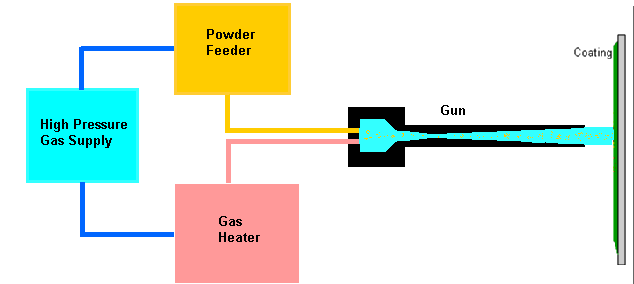COLD GAS-DYNAMIC SPRAY COATING PROCESS


The Cold Spray or cold gas-dynamic spraying process is the next
progressive step in the development of high kinetic energy coating
processes. Similar in principle to the other thermal spray methods, it
follows the trend of increasing particle spray velocity and reducing
particle temperature as with the HVOF/HVAF processes, but to a more
extreme level that it could be asked whether the process fits under the
description of thermal spray.
The Cold Spray process basically uses the energy stored in high
pressure compressed gas to propel fine powder particles at very high velocities
(500 - 1500 m/s). Compressed gas (usually helium) is fed via a heating
unit to the gun where the gas exits through a specially designed nozzle
(laval type convergent-divergent nozzle mostly) at very high velocity. Compressed gas is also fed
via a high pressure powder feeder to introduce powder material into the
high velocity gas jet. The powder particles are accelerated and
moderately heated to a certain velocity and temperature where on impact
with a substrate they deform and bond to form a coating. As with
the other processes a fine balance between particle size, density,
temperature and velocity are important criteria to achieve the desired
coating.
The particles remain in the solid state and are relatively cold, so
the bulk reaction on impact is solid state only. The process imparts
little to no oxidation to the spray material, so surfaces stay clean
which aids bonding. No melting and relatively low temperatures result
in very low shrinkage on cooling, plus with the high strain induced on
impact, the coatings tend to be stressed in compression and not in
tension like liquid/solid state reactions of most of the other thermal
spray processes. Low temperatures also aid in retaining the original
powder chemistry and phases in the coating, with only changes due
deformation and cold working.
Bonding relies on sufficient energy to cause significant plastic
deformation of the particle and substrate. Under the high impact
stresses and stains, interaction of the particle and substrate surfaces
probably cause disruption of oxide films promoting contact of
chemically clean surfaces and high friction generating very high
localised heating promoting bonding similar to friction or explosive
welding.
Coatings at present are limited to ductile materials like aluminium,
stainless steel, copper, titanium and alloys. Hard and brittle
materials like ceramics can not be sprayed in the pure form, but may be
applied as composites with a ductile matrix phase. Substrate materials
are also limited to those that can withstand the aggressive action of
the spray particles. Soft or friable substrates will erode rather than
be coated.
The cold spray process is still primarily in the research and development stage and only now becoming commercially available.
Cold Spray Process Advantages:
Cold Spray Process Disadvantages:
Possible Uses for Cold Spray Coatings:
